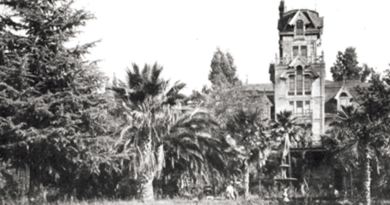History: Incarcerated women, then and now

Two hundred years ago, women were usually housed in the same prisons as men. But that changed in 1873, when two Quaker reformers, Sarah Smith and Rhoda Coffin, opened the first public prison for women in the United States — what would later become known as the Indiana Women’s Prison.
History, it turns out, has a lot to tell us about the current state of women’s incarceration. Today, around 172,000 women are incarcerated in the United States. But although they make up less than 10% of the total jail and prison population, women’s incarceration rates have grown at twice the pace of men’s according to the Prison Policy Initiative.
A new book, Who would believe a prisoner?, coming out in April, tells a number of shocking stories, ranging from a prison doctor who used his position as cover for nefarious medical research to private prisons run by the Catholic Church. The work, with chapters written by 10 incarcerated or formerly incarcerated women, challenges many of the things that historians though they knew about the Indiana Women’s Prison.
“By researching incarcerated women of the past … we could revive and tell their stories while slyly critiquing the current carceral state,” co-editor Michelle Daniel Jones wrote.
The women’s research, which began in 2012 as part of a history class in a prison education program, was intended to be a short brochure. But there was so much material that the scope of the project quickly ballooned as the women found more questions than answers. Ultimately, the book complicates the narrative surrounding the prison’s founders.
The team behind the book also had to fight for their own legitimacy throughout the process. Not only are the perspectives of their subjects — incarcerated women — often left out of dominant historical narratives, the incarcerated researchers also risked being dismissed because of their own status.
“We were not supposed to be legitimate, serious scholars doing legitimate work and really changing the narrative,” said Anastazia Schmid, who wrote several chapters. “Hence the title of the book, Who would believe a prisoner?”
‘I am one of those women’
Schmid’s research honed in on Theophilus Parvin, who served as the prison doctor in the institution’s early years. He would later be remembered as one of the foremost gynecologists of the late 19th century.
Schmid was immediately skeptical when she came across records of his work 130 years later: What exactly was someone like Parvin, a prominent physician who served as the president of the American Medical Association, doing at a women’s prison in a backwater state? Schmid suspected the doctor might be using his position as cover for using the women as human guinea pigs.
Professor Kelsey Kauffman, who taught that first history class, asked Schmid what theoretical basis she had for such a wild theory. Other scholars had, after all, documented Parvin’s unquestionable contributions to fields of gynecology and obstetrics.
“I know,” Schmid shot back, “because I am one of those women.”
Schmid’s own traumatic experiences with prison health care after she was incarcerated in 2001 informed her approach to historical research. During her incarceration in Indiana, she spent two years at a state psychiatric hospital in a state of “chemical restraint,” where she was drugged with an extreme and potentially lethal amount of psychotropic medications, she said.
Based on her own lived experiences, she was sure the doctor was exploiting incarcerated women as human guinea pigs. Parvin would have seen the prison as the “most opportune space to … poke and prod and do whatever the hell he wanted to do to these women,” she said. As Schmid researched further, her hunch was correct. Parvin conducted medical trials, subjected women to experimental surgeries, and tested drugs on them.
“Myself and probably every other women in this project, somewhere along the lines of the research, we found one of these women in history whose story so closely paralleled our own experience,” Schmid said.” How could we not highlight the women themselves in their stories?”
A missing piece of history
Prior to 1873, women who were convicted of crimes in Indiana were housed at the men’s prison in Jeffersonville. Smith and Coffin sought to create a more gentle, humane institution run by women for women. So, they opened the Indiana Reformatory Institution for Women and Girls, the prison’s original name.
“It was supposed to be a very … feel good kind of story,” said Schmid, who was released in 2019 after a federal court overturned her conviction. After finishing a graduate program in medical humanities, she now works as an independent scholar.
But what Schmid and her peers found was not the expected tale of female reformers rescuing female prisoners from male institutions. The women under Smith and Coffin’s care were often subjected to unsanitary conditions, corporal punishment, and grueling work in the name of saving their wayward souls.
To help offset the cost of running the prison, the women labored in the prison laundry and helped fulfill manufacturing contracts by sewing overalls and shirts. In essence, the authors describe a 19th century blueprint for modern, for-profit prisons.
They also found that the Quakers weren’t the only religious group attempting to get poor women and girls back on a righteous path. The research team discovered that women convicted of prostitution had been incarcerated in private facilities run by the Catholic Church prior to the opening of the public prison — a missing piece of the history of women’s incarceration.
Origin Stories
As the realities of what happened at the first women’s prison come to light, the research team lifted up the stories of incarcerated mothers, daughters, and sisters who were very nearly forgotten by society. Almost every chapter in the book is named after one of the women they found mentioned in the archives.
It wasn’t just the stories of historical figures like Belle, Minnie and Mary Jane — all women who had been incarcerated at the Indiana Women’s Prison in the 19th and early 20th centuries — that they hoped to tell. The research team also wanted to focus on women because they are often overshadowed by men in contemporary discussions of mass incarceration, Schmid said.
They also took a research approach that acknowledged their own positionality to their subjects. “We just really own that the way in which we are observing the archive is valid, even in this captive experience,” said Daniel Jones, who was released in 2017 and is now a Ph.D. student in American Studies at New York University.
She said she wanted to write the history of the Indiana Women’s Prison to help people understand women’s incarceration today.
“I’m a person who’s interested in origin stories: how in the fuck did we get here?” Daniel Jones said. “We’ve got to go back to the very, very beginning.”



